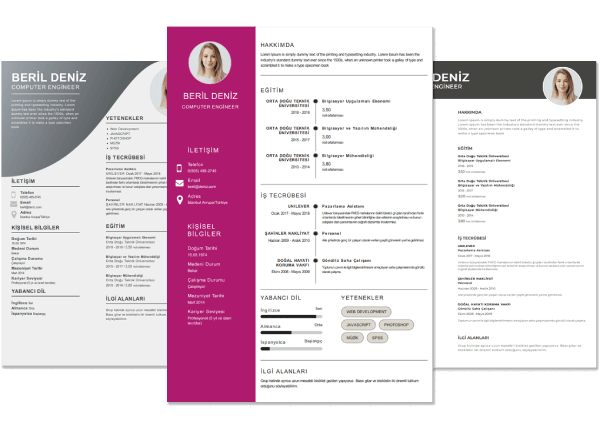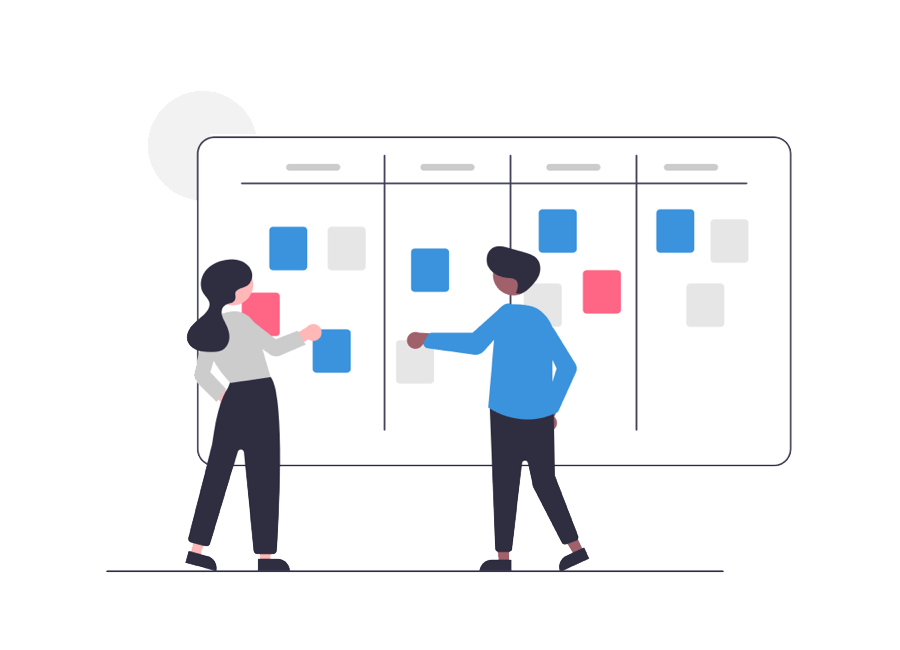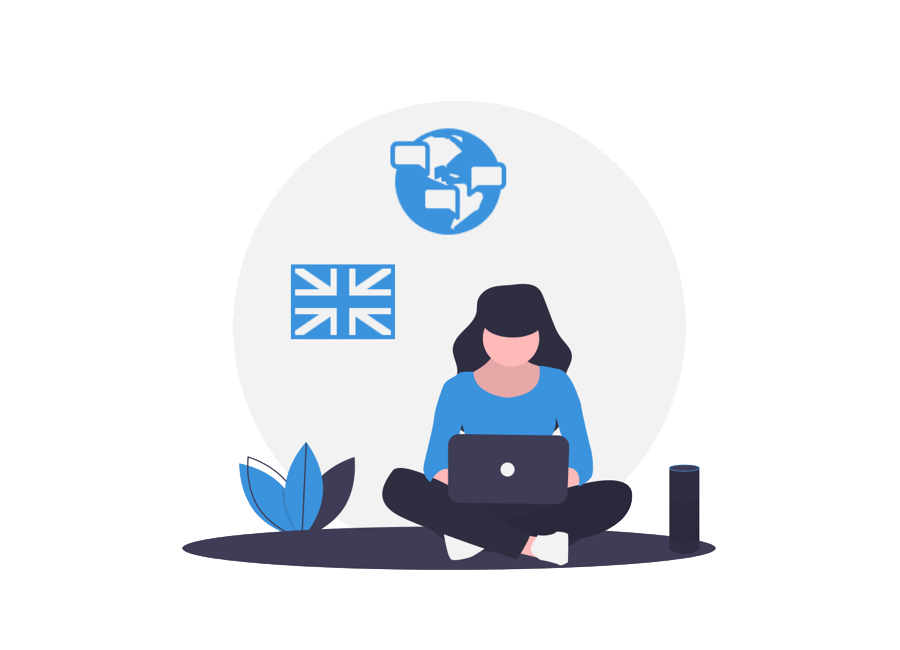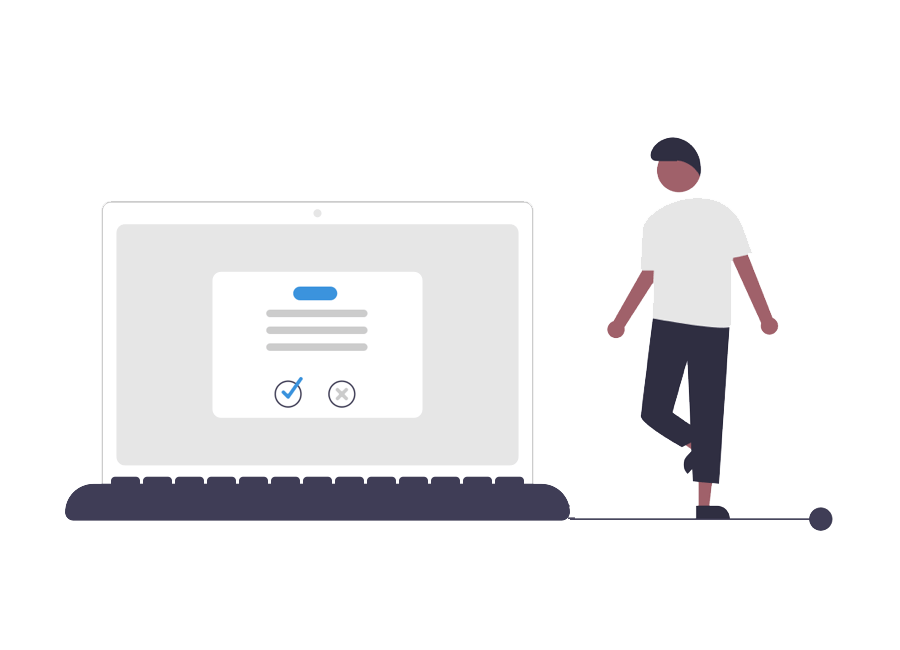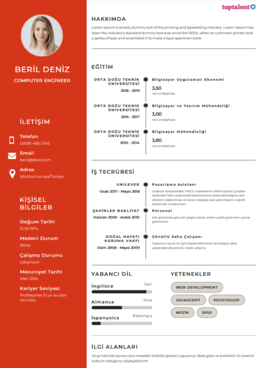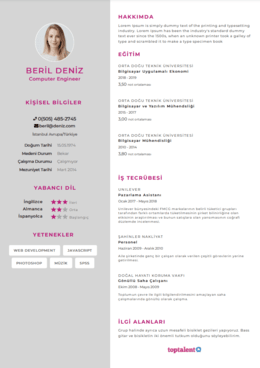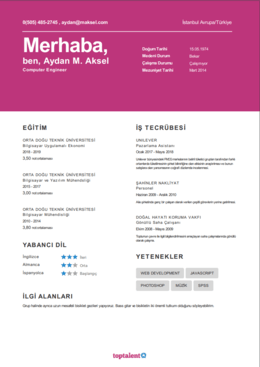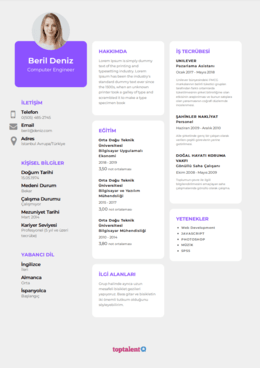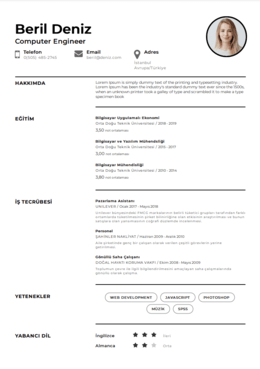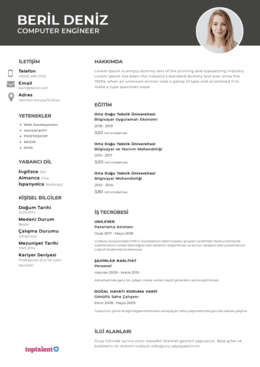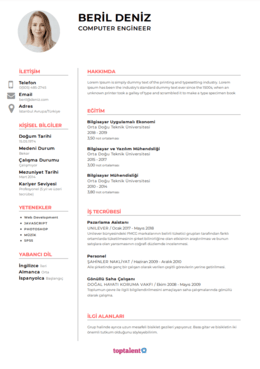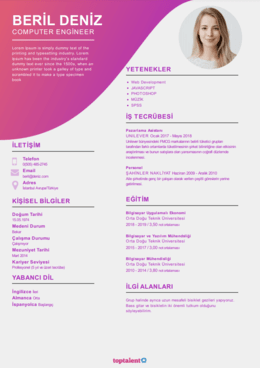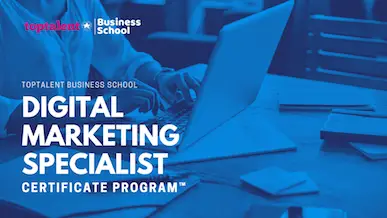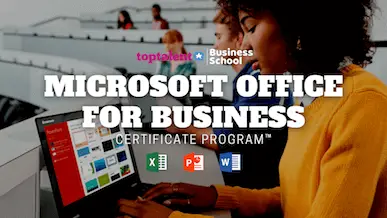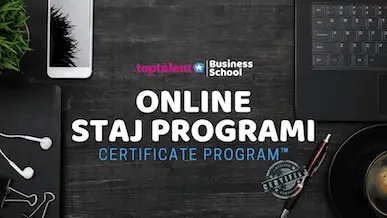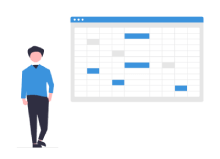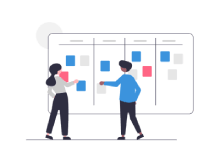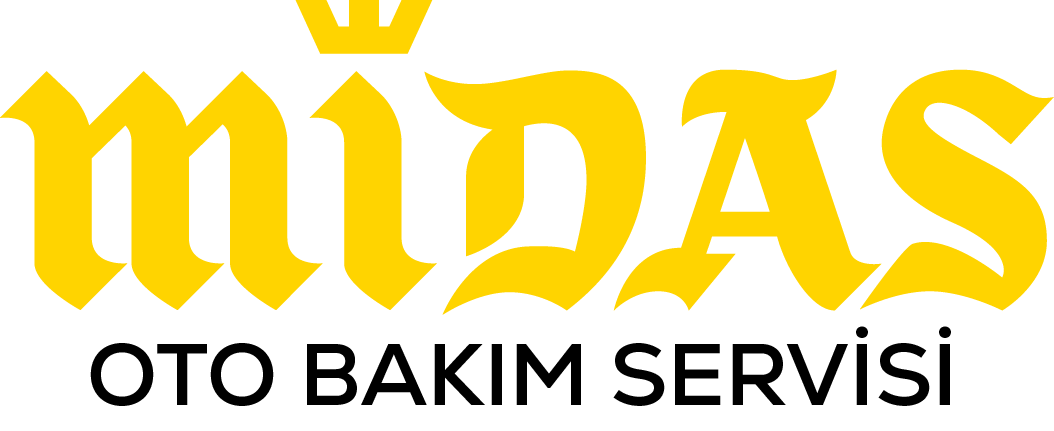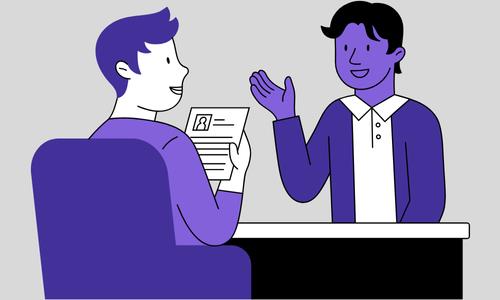Resume Help Pelin Özbilgin
How to Make a Resume: Writing Guide, Tips & Rules for 2022
Yeni CV örneklerini inceleGetting a job interview is a race against time because many applicants have already submitted their resumes for *your* dream position.
How can I overcome them and obtain that position?
Let's get started with our detailed tutorial on how to create the ideal resume.
Would you like to cut down on time and have your resume ready in 5 minutes? Use our resume generator. It is quick and simple to use. In addition, ready-made content is available for quick addition.
Here are the 10 easy steps to creating a resume:
- Choose the right resume format for you.
- Select a resume template that suits your personnality and industry.
- Include your name, contact information, and job title.
- Create a strong resume objective or summary.
- Describe your prior employment and major accomplishments.
- Clearly state your education.
- Include pertinent qualifications that are appropriate for the job posting (hard & soft skills).
- Include any crucial addenda to your resume.
- Write and send a cover letter for your resume.
- Your resume should be properly edited, downloaded, and sent.
Here is a guide on how to write an expert resume:
Select the Proper Resume Format
You can't just begin writing a resume by randomly entering your information into the resume template.
Instead, first select from the standard resume formats:
Format in reverse chronological order
Advantages: Potential employers are familiar with the traditional resume format.
Disadvantages: Not the most inventive resume design format, and very popular.
Format in combination
Advantages: Excellent for highlighting transferable skills for career changers and seasoned professionals.
Disadvantages: Not recommended for entry-level job seekers; uncommon type; less familiar.
Functional style (skills-based)
Advantages: Entry-level job seekers can highlight their skills over their lack of experience.
Disadvantages: HR managers might suspect you of lying.
The reverse-chronological resume format is likely to be preferred by the majority of job seekers.
The chronological resume is a typical resume structure which emphasizes your duties, experience, and work history. You'll put your most recent positions first, and travel back through former jobs in reverse-chronological order from there. It is frequently the simplest to read and scan because it is the typical, fundamental resume format.
How do you spell resume, by the way? Although it's still up for debate, we believe that a resume sans accents is the best option.
Compare the typical resume format samples or read our articles on the chronological, combination, or functional formats and resume design to discover more about the ideal resume format to employ for your specific situation. Check out our guide to free resume templates as well.
Resume Advice: Several studies have hypothesized connections between resume signals and an applicant's personality and employability, which could affect hiring decisions through resumes. Take caution when deciding which information to provide!
Add Your Contact and Personal Information
A seasoned diplomat is aware of which details to divulge and which to keep private.
Similar to a great resume, a great resume contact information section has some essential information that you must include, some recommended personal information, and other information that you should never provide:
Contact details that are essential:
- Name: Initials and last name (middle name optional).
- Phone: A personal cell phone should be used instead of a home phone.
- Email address: Today's preferred method of communication is email.
- LinkedIn address: Add your LinkedIn profile in (hiring managers will spy on you anyway).
Optional:
- Skip including your address on your resume (unless required)
- Title of the resume
- Personal webpage
Nowadays, listing personal websites and social media accounts in the heading of a resume is commonplace.
Special advice for marketing? Perhaps. However, employers will research you online. Your expert blog will undoubtedly rank first in Google and make a significant remark.
Contact information to avoid:
- Birthday date: Your birthdate could cause ageism if you include it. Add only when necessary, as for jobs like providing alcohol.
- Second email or phone number: They will be confused if you provide them a second email address, mailing address, or phone number (and you).
- Photo/Headshot: In the US, it's typically not advised to use resume photos or profile photos.
Resume Tip: Instead of using your old high school handle (sexypapa69xoxo@....) or an out-of-date email provider (....@hotmail.com), provide them a professional email address. A formal email account is far more employable than an informal one, according to studies.
Use a Heading Statement (Resume Summary or Resume Objective)
The majority of Tinder users lack patience. A clever remark or an eye-catching photograph is necessary to convince a match to swipe right on you.
In any case, the employer scans through resumes like a distracted Tinder user. According to our HR statistics research, hiring managers examine your CV and reach a preliminary judgment in less than 7 seconds.
Because of this, it's crucial to get the professional resume heading statement properly. You must craft a clever remark that presents a positive impression of your candidacy. After all, the goal of a resume is to present you in the strongest possible light as a candidate.
Since it's at the top of the page, your resume objective or summary statement is probably going to get the most attention.
In order to get the recruiter to swipe right on your CV, use these tips:
Summary statement for resume
Possess sufficient relevant expertise? Pick a summary statement for your CV.
When you apply for a position in which you have experience, a strong resume summary is effective. Your qualifications and experience in relation to the post are outlined.
Let's examine both appropriate and improper professional summary writing techniques:
RIGHT
Graphic designer with more than four years' experience in a dynamic international marketing company. Reliable and personable. Achieved the highest quality satisfaction score in the company, per an internal review (99.76 percent). Seeking to develop professionally while working with the DeZine team.
WRONG
For the past four years, I have worked as a graphic designer. I handle some challenging customer accounts in addition to having knowledge of many software and design programs. I also have the ability to perform well under pressure and meet even the tightest deadlines.
See the variations in this? The wrong one lists some experience but focuses on routine tasks rather than achievements. You provide proof of your IT consultant resume's talents, accomplishments, and experience in the appropriate example.
Resume Tip: The employer was referred to specifically in the "correct" resume summary above. In contrast to simply sending your resume to every employer out there, this is a terrific approach to ensure that it feels customized.
See more samples of resume summaries.
Objective statement for a resume
If you have no work experience at all, or at least none that is relevant to the position you are applying for, use the resume objective statement (entry-level applicants, career changers, students, etc.).
You will emphasize transferable talents from other fields since you lack pertinent experience to summarize. Even though you lack experience for this role, you will argue that your experience is still applicable.
Let's examine some more excellent and poor examples of resume objectives:
RIGHT
A diligent Customer Service Specialist with more than three years' experience working for a major computer hardware manufacturer earned the highest marks in quality and build spec knowledge (100%) (97.3 percent). I'm an entry-level IT technician looking to advance my career by learning with the BQNY team.
WRONG
I'm a Customer Service Representative who wants to work in the field. Although I lack experience in the sector, previous coworkers have praised my aptitude for learning quickly. I am really motivated since I prefer working outside to sitting at a desk in a cubicle.
See the variations in this? By hiring someone without certain experience, the organization is taking a bigger risk.
You'll therefore need to prove to them that you are capable.
In the correct one, we utilized some transferrable abilities from the prior employer and some humbling resume accomplishments... with figures.
Recall that numbers are more persuasive than words.
The incorrect candidate doesn't demonstrate enough to keep the hiring manager's interest.
Resume Tip: If you noted, both "bad" examples above used the first-person. On your resume, omit this.
See further samples of resume objectives. And for experienced candidates it's good considering a summary of qualifications too.
Drag and drop the bullet points, abilities, and tedious information when creating a resume using our builder. Use spellcheck. Check. Create a professional resume template right now for nothing.
List Your Relevant Work History and Major Accomplishments
The experience part of your resume is the main course, if you imagine it as a luxury meal. It contains the elements that are most crucial to include in a resume.
The earlier sections served as the appetizer; now, before continuing, fill in your employment history and prior accomplishments.
Let's now go over the various job history elements of the ideal experience section on a resume.
How to format the work experience portion of a resume:
You can see our suggested structure for your career history in the job experience area by referring to the infographic up top:
- Job Title: To make it simple for potential employers to scan and identify, the job title should be at the very top of each entry of your employment history. Make it bold and/or enlarge the font by one or two points in comparison to the remainder of the entry.
- Company, City, State: On the second line, list the name of the company you once worked for as well as the city and state where you were employed.
- Dates Employed: In the third section, list your employment dates. There is no requirement to include specific days; you can add the year, the month, or both.
- Important Responsibilities: In your career history, don't just write every single task you performed. Focus on the few tasks that are most important to the new position.
- Key Achievements: Important but frequently disregarded key accomplishments. Although employers are aware of what you accomplished, they also need to know how well you did it.
- Keywords: The experience portion of a resume should be sprinkled with resume keywords (more on this in a moment).
If you're adding more than one job history entry to the experience part of your resume or CV, start with the most recent role and work your way backwards in reverse chronological order.
Make your case for the duties and accomplishments listed in each entry using five or six bullet points.
Additionally, the bullet points for your experience section resume should be placed near the top, immediately beneath your header. Put your schooling part above your work history if you have little to no professional experience.
Have many job titles within the same organization or a promotion you wish to brag about? Do not fear; we will show you how to display promotions and various positions in our tutorial.
The most important part of your entire job application is the work experience section of your resume where you include your previous positions. Make sure to do it correctly.
Customizing your work experience resume:
Robots are assuming control.
Larger firms are turning to applicant tracking systems (ATS) for assistance as hiring procedures continue to evolve. The initial steps of the hiring process are automated by ATS software. How? They search for keywords and give each contender a score.
As a result, you absolutely must customize your resume, and you'll do this primarily in the experience area.
Go return to the job description and search the resume keywords associated with your responsibilities to custom-tailor your resume.
Include whatever duties you can find in the bullet points of your resume job description.
Had a period of unemployment? Be at ease! For information on how to explain gaps on your CV, see our guide.
Knowing how long a resume should be helps you tailor your resume. There are advantages and disadvantages to both a one-page and a two-page resume, but stay away from anything longer.
Additionally, avoid using old phrases like "responsible for" in the employment experience section of your CV. Choose strong words and active verbs instead to keep their attention. When speaking about prior experience, use the past tense instead of the present.
Finally, avoid using passive voice because it comes out as evasive and ambiguous. Instead, use the active voice because it is clear and to the point while creating a resume:
WRONG
Groth team was managed by me.
RIGHT
I managed a growth team.
How many years of experience should be listed on a resume?
A resume should, in general, not go back more than 10–15 years. But the length of your CV is less important the more experience you have. If you're a highly experienced candidate, don't try to fit everything into a one page resume.
Executives and managers applying for senior positions should mention up to 15 years of relevant professional experience, introducing each bullet point with strong action verbs.
Mid-level job applicants should include thorough explanations of any pertinent positions on their resumes, along with a brief mention of any additional positions.
Entry-level candidates should list and briefly summarize all employment that was compensated, highlighting the duties and accomplishments that are most pertinent.
First-time job seekers without work experience can still add other information in their experience area, such as involvement in a student organization, an internship, or volunteer work.
Keep in mind that the best resume templates will highlight your experience and qualifications while you learn how to construct a resume. Don't cover it up with a poor resume layout, an incorrect order, or an uninteresting template. With dozens of good resume examples, templates, and styles, Toptalent is the best resume builder online.
Correctly List Your Education
The education part is sometimes overlooked, but you shouldn't. It's crucial to the format of your resume.
Here's how to put education on your resume so you don't get schooled:
- Your highest degree should be first on your educational list on a resume.
- Reverse-chronologically order any additional degrees after that.
- Don't include high school information if you have a university degree.
- It's acceptable to list completed credits from some college coursework on a résumé.
- Include any accolades, awards, or courses that is pertinent (such as earning the Dean's List).
- A lovely finishing touch are extracurricular activities.
Simple, huh?
Resume Tip: If you have little to no work experience, put your education part at the top and your experience section below it. We have mentioned this, but we'll say it again just in case. Otherwise, keep the education part of your CV underneath your employment history.
On your CV, it is advisable to omit your GPA. It will only work against you if it isn't perfect.
If you have a GED or didn't finish high school, do you want to know how to make a resume education section? Not sure about the right structure for a resume for education? For information on how to list schooling on a resume, see our article.
Resume Tip: Avoid lying in the education area of your resume or CV. A diploma that is one credit short is not a diploma. Don't round up your GPA either. However, many business degrees don't always lead to better employment opportunities.
Put In-Demand Skills in The Section For The Job
Think of a piece of meat (the cow variety, not Chris Hemsworth).
Now picture a nicely grilled and seasoned steak.
Your resume falls into one of two categories: either it's a bad resume, the prime cut strewn with the wrong resume skills, or it's a nice resume, prepared to be served.
Contrasting hard and soft skills
Hard talents are specialized knowledge and capabilities (e.g., Photoshop, cash register).
Soft talents are traits that one develops through time (e.g., social skills, adaptability).
These taken together represent a job seeker's variety of talents and competencies, or skill set.
Resume Tip: Avoid mentioning irrelevant talents! A chef's resume shouldn't mention your photoshop talents, and an IT resume shouldn't mention your veterinary expertise.
How do I list my skills on a resume?
Spreading your skills throughout your resume is the key when thinking about how to write a CV that will undoubtedly stand out. But having a sizable section titled "SKILLS" also makes sense.
Do you still have the handy job description you had earlier?
To help you design a stellar resume for a job that will make the ATS light up like Times Square, use the important work-related abilities and keywords given in the job description.
The following is a list of typical talents to list on a resume:
- Social skills: nonverbal communication, listening skills, and interpersonal skills are all examples of communication skills.
- Technical skills: Knowledge necessary to carry out particular jobs, such as computer or administrative expertise.
- Job-specific skills: specific aptitudes needed by the employer.
- Leader and management skills: Being a good manager, leader, and supervisor requires leadership and management abilities.
- Critical thinking skills: ability to take initiative and make judgments independently using critical thinking skills. includes the ability to think critically, make decisions, and solve problems.
- Organizational talent: The capacity to organize, coordinate, and complete tasks.
- Transferrable talents: are abilities that career changers have acquired and can apply to their new role.
Resume Tip: Don't just type "skills for a [industry] resume" into Google and paste the results. As we discussed earlier, take the time to customize your resume's skills list to the job posting.
How should talents be listed on a resume?
A skill list can be presented on a resume in a variety of ways. Most people only need a straightforward skills section with 5–6 core skills and your competency level.
To provide them more precise information about the areas of the talent you specialize at, you could choose to list your unique knowledge under each item for specific job titles and technical skills.
Resume Tip: Not all skills are relevant to include on a resume! It's like boasting about being able to use a fork to say you can use Microsoft Word.
A strong skills section on a resume takes up little space but has a big impact. Find out what essential abilities to include on a resume for further information on how to create a skills section.
Include More Significant Sections On Your Resume
The truth is, such sections are on everyone's resumes. But what specific information should be in a resume?
By adding more resume sections, you may make your resume stand out.
Additional sections on your CV or resume can highlight a wide range of information about you, including your prestigious accomplishments, your fluency in other languages, and more.
Here's how to add more parts to your resume to make it stand out:
Hobbies and passions
You might not imagine that a future employer would be interested in your love of baseball and your work as the Little League assistant coach.
However, mentioning your likes and hobbies quietly demonstrates your capacity for teamwork, and the coaching can attest to your leadership and management skills.
Voluntary service
According to studies, volunteering increases employability. The majority of job seekers find that including any volunteer work in one of their other CV sections is a terrific approach to demonstrate their devotion and morals. It also demonstrates to them that you are not solely concerned with making money. Volunteering is a great substitute for experience for entry-level or first-time applicants.
Internship history
Only those who are recently out of school, who have held one or two other positions, or who haven't been on the job market for more than four years should list internships on their resumes.
Awards and certifications
Do you have any credentials to display, such as licenses or honors? Include them if they are pertinent to the position and the sector!
Languages
Know a second language? Impressive!
Particularly at multinational corporations or places where a sizable portion of the population speaks that second language, include language abilities on a resume only increases your employability. List the language, any regional variations (like Spanish spoken in Latin America), and your level of language proficiency.
Projects
If you've completed a lot of projects, you can include them separately in a section or just briefly mention a few underneath each job description.
Publications
Have articles been written for a newspaper, blog, or scholarly journal? On a resume, mention those publications. Make a brief bibliography of the works you want readers to credit if your published work isn't already available online.
Additionally, think about creating an online portfolio to keep track of everything if you've produced graphic designs or other creative products, or if your list of publications or projects is too large to include on a resume. In this scenario, link to it from the contact page.
Add A Cover Letter to Go Along With Your Resume
Definitely include a cover letter with your submission.
You can go into more detail about things that you need to keep on the resume in your cover letter or job application letter. Additionally, it makes it easy for you to speak in regular sentences!
Overkill, you say?
Think again.
Most employers believe that a CV is not sufficient to make a choice.
You can complete this task quickly and easily by following our tutorial on how to create a cover letter (or a cover letter for an internship or one without experience).
The Correct Way to Proofread, Save and Email Your Resume
Don't send it off just yet; you're almost there.
For peace of mind that you created the ideal CV, keep in mind the following best practices.
Double-check and proofread
Before sending out your draft CV or resume, double-check it. Use a program like Grammarly to check your email, cover letter, and resume. Then, have a friend or relative double-check everything.
Safer to be safe than sorry!
Resume Tip: For further information, see our recommendations on resume tips and resume errors to avoid.
Present on the web
Do you recall our conversation on LinkedIn and social media in the previous section on contacts? Do you still recall the nude photos you uploaded on Facebook a few months ago?
Yes, those ought to be taken down.
You best clean up your web presence before a recruiter or hiring manager has a chance to check you up and your career history! While you're putting together your resume, you should delete any inflammatory posts or at the very least label them as private. While you're at it, make any necessary updates to your LinkedIn profile to ensure its accuracy.
Resume Tip: Unless the job posting clearly instructs you to do so, avoid sending your email to the company's catch-all public email address. Find the HR manager's personal email address.
Keeping a resume
PDF or Word Doc? Hiring managers favor resumes in PDF format. Microsoft Word.doc type resumes are preferred by recruiters. Go with what you prefer in the end (and know that our builder will let you download in both file formats). Additionally, if you're generating your resume in Word, keep in mind that saving it as a PDF will preserve your formatting more effectively.
How do you save a resume? Use a naming convention for your resume that contains your name, hyphens or underscores, the position you're applying for, and the words "resume" or "cover letter" throughout all of your attachments.
RIGHT
maria-doe-marketing-specialist-resume.pdf
maria-smith-buyer-cover-letter.docx
Resume Tip: Before emailing your resume, be sure the job description says that applicants must send emails with a specified subject line. If not, use the title of the position, any required job reference numbers, your name, and the word "resume."
How do references appear on a resume? They should not be on a resume at all, although references may be listed alongside a resume.
To make it readable
If the employer can't read it, the entire document you're creating is pointless. By bearing the following in mind, you may make it simple for them to scan:
- Pick a basic font for your resume that will look good on most computers, such as Cambria, Calibri, Arial, Times New Roman, or Helvetica. No cursive!
- Select a font size of 11 or 12 points and single line spacing for the ordinary text. For section titles, increase font size to 14–16 points. Don't make the margins on your resume too narrow.
- To emphasize certain words or phrases, use bold type. For supporting text, use italics. Avoid underlining on your resume because it looks cluttered (and URLs already use it).
- Any section heads should alternate between serif and sans-serif (or vice versa) to complement the text's default font. For instance, you can combine the Times New Roman typeface with either the Calibri font (sans-serif) or Arial font (sans-serif) (serif).
- Additionally, if you plan to print your resume, use the nicest paper you can afford; it will give it a more polished appearance.
Be reliable
Consistency is important in both your resume draft and as their potential employee. For instance, format your dates whatever you'd want (15 Nov, November 15, 11-2021, etc.), but do so consistently.
Discover resume icons for each component of your resume if you find one to serve as the introduction, otherwise omit the sections altogether. Ensure that the margins on your resume are the same width on all four sides.
Avoid switching between verb tenses or using the incorrect verb tenses. Use the past tense if it was a former position that you no longer hold.Use the present tense when listing a current position. Keep them the same throughout, whatever you do.
The proper method to email your resume
Your resume and cover letter will be buried in a sea of similar emails from job applicants vying for the same position as you if you send them to a catch-all email address like contact@company.org.
Find the person's name who will be reading your resume, and include that information in your email to make it more personalized. When you address a resume to Dear Susan rather than To Whom It May Concern, it comes off as lot more compelling.
Additionally, a strong cover letter that complements your CV will set you apart from other applicants.
Key Learnings
We are aware that was extremely detailed. So, here are some general resume building tips:
- Maintain relevancy: Each and every item on your resume should demonstrate why you are the greatest candidate.
- Tailor: Create a customized resume for each job and firm you intend to apply to. Choose the firm and the relevant abilities for the open position.
- Pick the appropriate items: Use active voice, create a heading statement that fits your circumstance, and omit any pointless facts when writing your essay.
- Be reliable: Follow the same layout, styles, color schemes, and conventions throughout your resume to maintain consistency.
- Cross-check: Verify again before sending your resume out to ensure there are no grammatical or spelling mistakes. Consult a friend for assistance or review a resume critique.
- Create an online resume: Create a resume online using toptalent.co's simple resume builder to quickly construct your cover letter and resume. There are more than 20 resume examples and templates available to help you. You can be sure your CV will be strong and land you the desired job with the help of the hints and guidance it provides along the route. It is, in our opinion, the best resume builder available.
Do you have any inquiries about resume writing? Not sure how to create the ideal work experience section for your resume or how to create a list of abilities and accomplishments? We'll respond to your inquiries in the comments section below. Regarding your resume preparation, thanks for reading and best of luck!
Questions and Answers on Writing a Resume for a Job
How do I create a resume for employment?
Prior to writing your resume, thoroughly study the job description to identify the keywords you'll need to succeed on the applicant tracking software exam. Create the areas of your resume required to introduce yourself, your credentials, and your strengths. Sections include:
- Private information
- Professional synopsis or goal
- History of employment Education and skills
- Other things like accolades, credentials, and language licenses
You'll need to consider which supplemental sections are most effective given the industry and level of experience. But without the other five, you can't possibly write a resume. By using our resume builder, you can eliminate the stress.
How do you write your first resume?
Include transferable skills in the skills and resume objective areas of your first resume. Add accomplishments that demonstrate your abilities as a good employee, such as curiosity, a desire to learn and help, and improved communication skills, to the work history section. Placements for internships and volunteer work are ideal there. Most crucial, include your academic successes directly after the goal to draw attention to your progress in school.
How can I write a resume that will wow employers?
A resume that reads smoothly and appears professional is one that is impressive. Therefore, take care of the resume style and layout before you get to describing the specifics of your professional and academic achievements.
After that, go on to list your greatest achievements in each of the following categories: resume profile, experience, education, and skills. But additional components provide the best impression, so don't forget to list your extracurricular activities, accolades, and qualifications on your CV. Claim to be an achiever rather than a doer.
What format should a resume follow?
The most common resume structure, whether for an entry-level career, a specialty role, or an executive post, is chronological. You make the decision to flaunt your job advancement by selecting it.
When switching careers, a functional structure or skills-based resume puts you in the best possible light. It focuses on your skill set while pushing your work history to the side.
A well-balanced fusion of the chronological and functional styles is the combination format, sometimes known as a hybrid. The most difficult to write because it comprises an extensive experience part that is appropriate for senior positions and a description of your skills.
How can a resume be created in Word?
Use a pre-made Word resume template to save yourself the hassle. However, you should start creating your resume with Word if you have a lot of time and a lot of familiarity with text formatting. To avoid overwhelming the ATS, create a clear layout, pick a typeface that is easy to read, and keep the number of graphic components on the page to a minimum. Then, include the primary and auxiliary sections of your resume in a manner consistent with the format. Keeping in mind the recruiter's directions, save it as a Word or PDF file at the conclusion.
Alternatively, you can choose one of toptalent.co's resume templates, enter your information, and land that job if you need a professional resume that can be created in a matter of minutes and looks better than any Word resume.
What will a strong resume in 2022 look like?
You need to stand out even more than you did in the previous years in 2022. Use a current resume template and make sure to include the following sections: a summary or objective, a list of your qualifications, a history of employment, education, and skills. Under each section, list and measure your greatest accomplishments. Prove to your potential employer that you have had an influence and that you can deliver outcomes.
En iyi yeteneklerin kariyer platformu toptalent.co'ya üye ol, Türkiye'nin ve dünyanın en iyi şirketlerinin iş, staj ve kariyer fırsatlarını keşfet.
